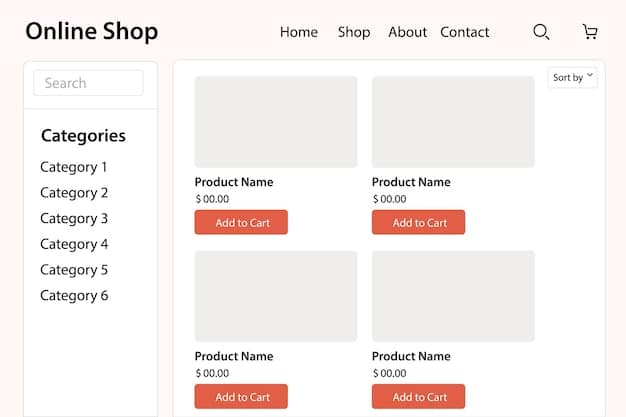Beat Dynamic Pricing: Use Price Comparison Tools in the US

Understanding dynamic pricing involves recognizing its fluctuations and leveraging price comparison tools to identify the best deals, empowering consumers to make informed purchasing decisions and potentially save money in the US market.
Have you ever noticed the price of an item changing multiple times in a single day? That’s dynamic pricing in action, and understanding dynamic pricing is key to navigating the modern marketplace. But don’t worry, with the help of price comparison tools, you can turn the tables and find the best deals in the US.
What is Dynamic Pricing and Why Does it Matter?
Dynamic pricing, also known as demand pricing or surge pricing, is a strategy where businesses adjust prices based on real-time market conditions. These conditions can include demand, competitor pricing, time of day, and even your browsing history. Understanding this can help you save money.
Why does this matter to you? Because dynamic pricing can significantly impact how much you pay for everything from airline tickets and hotel rooms to everyday items on e-commerce sites. Essentially, you might be paying more than someone else for the exact same product or service.
Factors Influencing Dynamic Pricing
Several factors contribute to these price fluctuations. Let’s break down some of the key elements that drive dynamic pricing:
- Demand: High demand usually results in higher prices. Think of concert tickets or hotel rooms during peak season.
- Competition: If several businesses offer similar products, they might lower prices to attract customers.
- Time: Prices can change based on the time of day or day of the week. Airlines are notorious for this.
- Personalized Data: Some websites track your browsing history and location to offer personalized prices.

Understanding these factors is the first step in taking control of your spending. Knowing *why* prices change empowers you to make smarter decisions and use price comparison tools effectively.
In conclusion, dynamic pricing is a pervasive practice that impacts nearly every aspect of online shopping. By understanding the factors that influence it, you can prepare to navigate the twists and turns of the modern marketplace.
How Price Comparison Tools Work
Now that you understand dynamic pricing, let’s dive into how price comparison tools can help you beat the system. These tools are designed to gather pricing information from multiple sources to provide you with a comprehensive overview of available deals.
Price comparison tools act as your personal shopping assistants, sifting through countless online stores and websites to identify the lowest prices. These are especially useful in the US market where there are so many retailers.
Types of Price Comparison Tools
There are various types of price comparison tools available, each with its own strengths. Here’s a brief overview:
- Websites: Dedicated websites that aggregate prices from many different online retailers.
- Browser Extensions: Add-ons to your web browser that automatically compare prices while you browse.
- Mobile Apps: Apps that allow you to scan barcodes or search for products on the go.
Each type of tool offers different levels of convenience. Browser extensions can be particularly useful because they work seamlessly in the background, alerting you to better deals as you shop.

In conclusion, knowing how price comparison tools work – and understanding the different types that are available – you can start saving money, so you can get the best possible deals without spending hours manually searching multiple websites.
Top Price Comparison Tools in the US
With so many price comparison tools available, it can be overwhelming to choose the right one. Here are some of the top options in the US, along with their key features and benefits.
When selecting a price comparison tool, consider factors such as ease of use, the number of retailers included, and any additional features like price tracking or coupon codes. Tailor your choice to fit your shopping habits and preferences.
Recommended Price Comparison Websites
Here are some great price comparison TOOL Websites:
- Google Shopping: A widely used platform that allows you to compare prices from a vast array of retailers. It also integrates with Google’s search engine, making it easily accessible.
- PriceGrabber: Known for its user-friendly interface and comprehensive coverage of various product categories, including electronics, apparel, and home goods.
- Shopzilla: Offers an extensive selection of products from numerous retailers, with features like user reviews and price alerts.
- CamelCamelCamel: Primarily focused on Amazon prices, this tool tracks price history and sends alerts when prices drop, making it ideal for Amazon shoppers.
In conclusion, the best price comparison tool for you will depend on your individual needs and preferences. Evaluate several options and experiment with different features to discover which one helps you save the most money.
Strategies for Using Price Comparison Tools Effectively
Using price comparison tools is just the first step. To really maximize your savings, you need to employ effective strategies. Here are some tips to help you get the most out of these tools.
By combining the power of price comparison tools with these strategies, you can become a savvy shopper and consistently find the best deals available.
Tips for Maximizing Savings
Follow these useful tips to get more savings:
- Set Price Alerts: Many price comparison tools allow you to set alerts for specific products. You’ll receive a notification when the price drops below a certain threshold.
- Check Prices at Different Times: As mentioned earlier, dynamic pricing means prices can change frequently. Check prices at different times of day to find the lowest rate.
- Factor in Shipping Costs: Some retailers may offer a lower price but charge more for shipping. Be sure to include shipping costs in your calculations.
- Look for Coupons and Discounts: Many price comparison tools also provide access to coupons and discount codes. Always check for these before making a purchase.
In conclusion, using price comparison tools effectively requires a combination of knowledge, strategy, and vigilance. By implementing these tips, you can navigate the complexities of dynamic pricing and consistently find the best deals.
Common Pitfalls to Avoid When Using Price Comparison Tools
While price comparison tools are incredibly useful, they aren’t foolproof. There are some common pitfalls to avoid to ensure you’re getting accurate and reliable information.
Awareness of these pitfalls can help you avoid costly mistakes and use price comparison tools more effectively.
Potential Issues with Price Comparison Tools
Beware of these potential problems with price comparison tools:
- Inaccurate Information: Price comparison tools rely on data feeds from retailers, which can sometimes be outdated or incorrect.
- Hidden Fees: Some retailers may not include all fees and taxes in their listed prices, leading to unexpected charges at checkout.
- Limited Coverage: Not all price comparison tools include every retailer, so you might be missing out on potential deals.
- Sponsored Listings: Some tools prioritize sponsored listings over the lowest prices, so be sure to look beyond the top results.
In conclusion, use price comparison tools with a critical eye, double-checking information and verifying prices with the retailer directly. By doing so, you can avoid common pitfalls and ensure you’re getting accurate information.
The Future of Dynamic Pricing and Price Comparison
As technology continues to evolve, both dynamic pricing and price comparison are expected to become even more sophisticated. Understanding these trends can help you stay ahead of the curve and continue to find the best deals.
The future of dynamic pricing and price comparison hinges on technological advancements and evolving consumer behavior. By staying informed and adapting your strategies, you can continue to navigate the changing landscape of online shopping.
Emerging Trends in Pricing Technology
Consider these emerging trends:
- AI-Powered Pricing: Artificial intelligence is being used to analyze vast amounts of data and optimize pricing strategies in real-time.
- Personalized Pricing: Expect to see even more personalized pricing based on individual browsing habits, demographics, and purchase history.
- Augmented Reality Shopping: AR technology could allow you to compare prices in real-time while physically browsing in stores.
In conclusion, the ongoing evolution of dynamic pricing and price comparison tools will require consumers to stay informed and adapt their strategies. By embracing new technologies and remaining vigilant, you can continue to find the best deals in an ever-changing marketplace.
| Key Point | Brief Description |
|---|---|
| 💡Dynamic Pricing | Prices change based on demand, competition, and personal data. |
| 🔍Price Comparison Tools | Websites, extensions, and apps that find the best deals. |
| ⏰Timing Matters | Check prices at different times for potential savings. |
| 🤖AI Pricing | AI is optimizing prices in real-time, making comparison crucial. |
FAQ
▼
The primary benefit is saving money by quickly identifying the lowest prices from multiple retailers, eliminating the need to manually check each site.
▼
While generally accurate, they rely on retailer data feeds, which may sometimes be outdated. It’s always a good idea to double-check directly with the retailer.
▼
Yes, dynamic pricing isn’t just for travel and hotels. Many e-commerce sites use it for everyday items, adjusting prices based on demand and other factors.
▼
Use privacy-focused browsers, clear your browsing history regularly, and avoid logging into your accounts while shopping to minimize personalized pricing based on your data.
▼
Verify the price directly on the retailer’s website. If there’s a discrepancy, contact the retailer’s customer service for clarification.
Conclusion
In today’s dynamic pricing environment, understanding dynamic pricing and mastering the art of using price comparison tools is essential for any savvy shopper in the US. By staying informed, employing effective strategies, and remaining vigilant, you can navigate the complexities of the marketplace and consistently find the best deals available.





